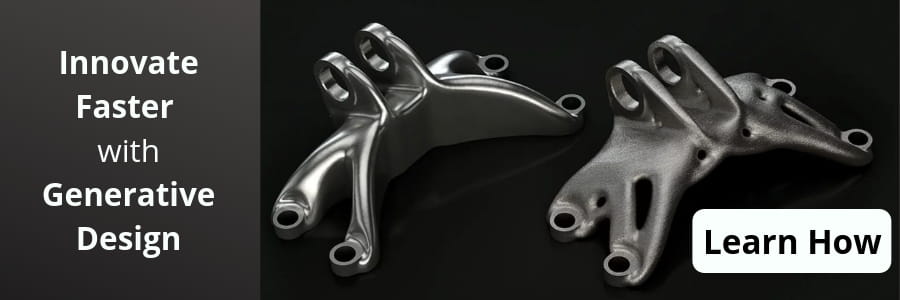The Leadership of Generative Design at PTC: Q&A with Jesse Coors-Blankenship
There are some journeys with predictable outcomes.
Bill Gates launching Microsoft, after a childhood spent tinkering with software — including an algorithm for pancake sorting while at Harvard. Steve Jobs co-founding Apple, after spending his formative years building and fixing things with his father in the garage.
For Jesse Coors-Blankenship, Senior Vice President of Technology at PTC, the journey was as predictable an outcome. As a professor at Columbia University, Blankenship was interested in how technology could solve large scale engineering challenges automatically and was already thinking about the way of the future of design by requirements instead of by hand.
The question for Blankenship was: How could he apply generative concepts to mechanical engineering? How could generative help designers improve conceptual design exploration, increase engineering productivity, and deliver better products faster?
Realizing there wasn’t a unified approach to generative in software design, Blankenship seized the opportunity to steer the 3D CAD market in a new and innovative direction. He put his research to work and founded advanced generative design software company Frustum, acquired by PTC in November 2018. Frustum’s mission was to help designers and engineers spend more time “engineering” and less time “detailing.” Frustum wanted to facilitate design creativity from the outset and enable engineers to realize their ideas in ways that had not been possible previously.
I sat down with Blankenship recently and asked about generative design and what it meant for Frustum to join PTC:
What is generative design?
Generative design is a way to autonomously generate optimal designs from a set of system design requirements. With generative design, engineers can interactively specify the functional requirements and goals of their design, including preferred materials and manufacturing processes—and the generative engine will automatically produce a manufacture-ready design.
Frustum technology enables designers and engineers to design generatively using artificial intelligence (AI) and powerful high-performance computing techniques to present design alternatives for consideration as a starting point or as a final solution. As a result, engineers can interact with the technology to create superior designs and innovative products more quickly.
What did it mean for Frustum to join PTC?
Frustum’s desktop and cloud-based engineering software enables designers and engineers to go beyond the limits of their personal experience by leveraging powerful AI capabilities that guide the discovery of high-performance, next-generation product designs.
PTC was the right fit for Frustum because of our shared vision: helping customers to push the limits of technology, transforming their businesses and allowing them to become more innovative, agile, and adaptive with their product offerings.
Generative design is appealing to PTC’s vast customer base as they seek ways to optimize new products for improved manufacturability, reduce material costs, and decrease manufacturing cycle times; create complex geometries optimized for additive manufacturing; and deliver better products faster.
How is topology optimization different from (and similar to) generative design?
Topology optimization and generative design have become buzzwords in the manufacturing and engineering community, but there’s a common misconception in the market that the two are synonymous. With the terms often being used interchangeably, this can create confusion and ambiguity.
Topology optimization is a foundational technology upon which generative design is built – and it’s been around for decades. It converges on a single solution based on functional objectives such as constraints and loads. Building on these same principles, generative design considers many possible solutions to arrive at the best solutions based on design requirements including both functional and non-engineering requirements.
Generative design utilizes topology optimization to explore all the possible permutations of a solution, continuously iterating and learning from the process. It’s a way of designing for the next generation of CAD – and it is changing the way engineers think about design.
How does AI factor into generative design?
AI is the use of technology and mathematics to create systems that perceive, learn, and act in order to enhance or replace human capabilities-augmented reasoning. This conceptualization of AI is critical in understanding PTC’s generative design offering. Integral to generative design is the goal of augmenting design expertise and capabilities by:
- Optimizing designs for multiple objectives simultaneously and providing a designer with several novel design alternatives, which enables companies to substantially reduce engineering cycles
- Creating constraint-driven design that would be non-intuitive to a human or that normally require deep expertise to optimize (essentially allowing less-experienced designers to create output comparable to more experienced experts)
How is generative design helping industrial enterprises drive digital transformation?
The development of an increasingly digital ecosystem involves investing in innovative technologies to drive business outcomes crucial to success. This includes engineering excellence, manufacturing efficiency, and product and service innovation, among others. This value is driven through technologies that link an organization’s products, processes, and people – what PTC calls the three pillars of digital transformation.
Generative design can help unleash digital transformation across the entire enterprise.
With generative, manufacturers can drive workforce productivity by proactively addressing the skills gap. An entry-level mechanical engineer can now create a part through generative design, without extensive knowledge of manufacturing processes that a senior engineer would have from years in the field.
Generative also allows engineers to explore traditional and advanced manufacturing techniques to get differentiated products, bringing value to not just productivity but to competitive differentiation. What’s more, it improves supply chain processes – imagine 25 parts to one part and the impact that has on processes. With generative, engineers can take advantage of advanced manufacturing techniques and embrace additive manufacturing.
Final Thoughts
With the Frustum acquisition—and the brains, talent, and passion for generative design that the Frustum team brings—PTC is pushing the boundaries of innovation. Frustum’s technology for generative design—an approach that leverages artificial intelligence (AI) to generate design options—will be a transformative addition to the PTC Creo portfolio.
